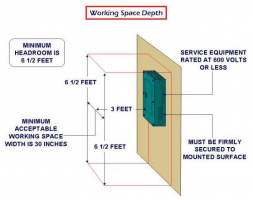Yikes
SAWHORSE
I'm working on an apartment building that was originally built in 1964. The apartment complex is master-metered, and inside every apartment is a 60A subpanel, which was originally mounted inside of the HVAC closet, just inside the closet door. (Of course we will fix that exposed wiring, but pay no attention to it for the moment, because that's no my question.)
The depth of the closet is about 30". I believe that under new code, we would need 36" depth, but did this requirement exist in 1964?
What we want to do is replace old breakers and install arc-fault breakers into the existing subpanels. We don't have enough money to relocate the panels, re-wire, and deal with disturbing walls that may have incapsulated lead paint or other issues. Is there a code rationale under which I can leave these panels in place? If this were the UBC, Chapter 34 would allow replacement in kind; is there something similar in the current NEC?

The depth of the closet is about 30". I believe that under new code, we would need 36" depth, but did this requirement exist in 1964?
What we want to do is replace old breakers and install arc-fault breakers into the existing subpanels. We don't have enough money to relocate the panels, re-wire, and deal with disturbing walls that may have incapsulated lead paint or other issues. Is there a code rationale under which I can leave these panels in place? If this were the UBC, Chapter 34 would allow replacement in kind; is there something similar in the current NEC?


